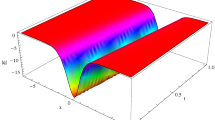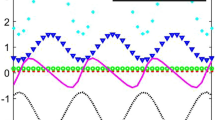Abstract
The aim of this work is to produce the effect of optical soliton cooling with polynomial law of nonlinear refractive index. This is achieved by the aid of soliton perturbation theory. In this context, both Hamiltonian and non-Hamiltonian type, including non-local type, perturbation effects are considered.
Similar content being viewed by others
Avoid common mistakes on your manuscript.
Introduction
Advances in optical soliton dynamics have reached far and beyond and its progress is beyond measure! There are a wide variety of aspects in soliton dynamics that has been touched upon during the past few decades. These include soliton perturbation theory, establishment of conservation laws, addressing highly dispersive solitons, numerical studies with short pulses by Laplace substitution, Bragg gratings, application of semi-inverse variational principle and implementing variational iteration method and several others [1,2,3,4,5,6,7,8,9,10,11,12,13,14]. It is quite noteworthy that research results on optical soliton cooling are few and far between [1, 4, 5, 7]. In the past, this effect was introduced with optical Gaussons and for solitons with Kerr law, power law, parabolic law, dual-power law and quadratic–cubic law [4, 5, 7]. The current paper thus is bridging the gap by addressing soliton cooling effect with polynomial law of nonlinear refractive index that is occasionally referred to as cubic–quintic–septic law. The perturbation terms considered to study the adiabatic soliton dynamics are of Hamiltonian as well as non-Hamiltonian types that also include non-local kind. The details are sketched in the rest of the paper after a quick re-visitation to the governing nonlinear Schrödinger’s equation (NLSE) along with its conservation laws.
Governing model
The governing nonlinear Schrödinger’s equation with polynomial law of nonlinearity, in its dimensionless form, is written as [3, 8]:
Here, the dependent variable q(x, t) is a complex-valued function with x and t being the spatial and temporal coordinates, respectively. The coefficient of a is chromatic dispersion, while the last three terms, the coefficients of \(b_j\) for \(j = 1, 2, 3\), are from self-phase modulation (SPM) effect that stems from nonlinear refractive index of the fiber. The first term is temporal evolution. The coefficients of dispersion and nonlinear terms are all real-valued constants, while \( i = \sqrt{-1}\). This form of nonlinearity has not been much studied. Some preliminary results have been reported for optical fibers and in Bragg gratings. The bright 1-soliton solutions to the model as recovered earlier are given by [3, 7, 8]
The parameter A is the soliton amplitude, while its inverse width is indicated by B and the velocity of the soliton is indicated by v. From the phase component, \(\kappa \) is the soliton frequency, while \(\omega \) is its wave number, and finally, \(\theta _0\) is simply the phase constant. The parameter relations with the coefficients of the equation terms are as indicated below:
The amplitude and width are expressed as
and
which instantly prompts two constraint conditions as
Also, from (4) and (5), the relation between the soliton amplitude and its inverse width is written as:
and thus, the existence condition, which immediately kicks in, is
Two of the conserved quantities, as shown earlier, are power (P) and linear momentum (M), and they are, respectively, represented as [3]
and
Soliton perturbation
The perturbed NLSE for polynomial law is: [7, 8]
where R represents perturbation terms, while \(\epsilon \) is the perturbation parameter. It stands for quasimonochromaticity that measures the relative width of the spectrum when perturbation terms are present. Thus, one must have \(0 < \epsilon \ll 1\) [1, 4, 5, 7].
When perturbation terms are turned on, the conserved quantities are adiabatically deformed, and thus, they slowly vary with time. The law of adiabatic variation of the two indicated conservation laws leads to the slow dynamics of power and soliton frequency as indicated below [1, 4, 5]:
and
The slow change of soliton velocity is governed by [1, 4, 5, 7]:
Adiabatic parameter dynamics
The perturbation terms as indicated by R, from this paper, are given as [4, 5, 7]:
In (15), \(\delta \) accounts for multi-photon absorption, while \(\alpha \) is the intermodal dispersion, \(\beta \) represents band-pass filters and \(\gamma \) is the third-order dispersion. Next, \(\lambda \) is the self-steepening effect, while \(\theta \) gives the effect of nonlinear dispersion and \(\rho \) accounts for nonlinear dissipation. Then again, \(\xi \), \(\eta \) and \(\zeta \) stem from quasilinear pulses, while \(\mu \) is from intra-pulse Raman scattering. Next, \(\sigma _j\) for \(j = 1, 2\) gives saturable amplifiers. Finally, \(\chi \) and \(\psi \) are associated with fourth-order dispersion and sixth-order dispersion terms, respectively. The parameter m represents full nonlinearity or maximum intensity.
With these perturbation terms, the adiabatic variation of the soliton power and frequency results in:
where in (16) and (17), the Gauss’ hypergeometric function is [4]:
with Pochhammer symbol:
The convergence of the series is guaranteed provided
Finally, Rabbe’s test of convergence yields another convergence criterion which is
and this case amounts to saying
Also, condition (20) when applied to (16) and (17) implies
Next, slow change in the speed of the soliton, from (14), leads to
Thus, the perturbed soliton will travel down the optical fiber, having polynomial form of SPM, with a fixed amplitude \(\bar{A}\) and width \(\bar{B}\) that maintain the speed of light. The relation between the amplitude and width is recoverable from the following polynomial equation, which is obtained from the fixed point of the dynamical system (16) and (17), after turning off the effect of Raman scattering:
Equation (25) can be solved for soliton amplitude in terms of its width for a few special cases of the parameter m. These are \(m = 1, 2, 3\) and 4. The last two cases can be solved by Cardano’s method and Ferrari’s approach, respectively. This is the phenomenon of optical soliton cooling for polynomial law of nonlinear refractive index in an optical fiber.
Conclusions
The phenomenon of optical soliton cooling is illustrated for polynomial law of nonlinearity. The fixed value of the amplitude for stable propagation of solitons is expressed in terms of its width through an transcendental equation. This was obtained from the fixed point of the dynamical system of power and frequency of the soliton. The results of this paper are thus interesting and have a wide range of applications in future. One would still need to consider the stochastic perturbation in addition to deterministic perturbation terms that would yield the mean free velocity of the soliton. Later, quasistationary optical solitons with polynomial law of nonlinearity are scheduled to be addressed. Another pressing matter is to take up the quasiparticle theory to suppress intra-channel collision of solitons propagating through an optical fiber with polynomial law of refractive index. Thus, there are a lot of avenues to venture!!
References
A. Biswas, S. Konar, Introduction to Non-Kerr Law Optical Solitons (CRC Press, Boca Raton, 2006)
A. Biswas, D. Milovic, Bright and dark solitons of the generalized nonlinear Schrödinger’s equation. Commun. Nonlinear Sci. Numer. Simul. 15(6), 1473–1484 (2010)
A. Biswas, M. Ekici, Q. Zhou, A.S. Alshomrani, M.R. Belic, Conservation laws for optical solitons with polynomial and triple-power laws of refractive index. Optik 202, 163476 (2020)
A. Biswas, Quasi-monochromatic dynamics of optical solitons having quadratic-cubic nonlinearity. Phys. Lett. A 384(21), 126528 (2020)
L. Girgis, D. Milovic, T. Hayat, O.M. Aldossary, A. Biswas, Optical soliton perturbation with log law nonlinearity. Opt. Appl. 42(3), 447–454 (2012)
O. Gonzalez-Gaxiola, Bright and dark optical solitons of the Schäfer–Wayne short-pulse equation by Laplace substitution method. Optik 200, 163414 (2020)
A.J.M. Jawad, M.J. Abu–AlShaeer, E.M.E. Zayed, M.E.M. Alngar, A. Biswas, M. Ekici, A.K. Alzahrani, M.R. Belic. Optical soliton perturbation with exotic forms of nonlinear refractive index. Optik (to appear)
R.W. Kohl, A. Biswas, Q. Zhou, M. Ekici, A.K. Alzahrani, M.R. Belic, Optical soliton perturbation with polynomial and triple-power laws of refractive index by semi–inverse variational principle. Chaos Solitons Fractals 135, 109765 (2020)
N.A. Kudryashov, A generalized model for description of propagation pulses in optical fiber. Optik 189, 42–52 (2019)
N.A. Kudryashov, Mathematical model of propagation pulse in optical fiber with power nonlinearities. Optik 212, 164750 (2020)
N.A. Kudryashov, E.V. Antonova, Solitary waves of equation for propagation pulse with power nonlinearities. Optik 217, 164881 (2020)
N.A. Kudryashov, Highly dispersive solitary wave solutions of perturbed nonlinear Schrödinger equations. Appl. Math. Comput. 371, 124972 (2020)
N.A. Kudryashov, Periodic and solitary waves in optical fiber Bragg gratings with dispersive reflectivity. Chin. J. Phys. 66, 401–505 (2020)
A.M. Wazwaz, A variety of optical solitons for nonlinear Schrödinger equation with detuning term by the variational iteration method. Optik 196, 163169 (2019)
Author information
Authors and Affiliations
Corresponding author
Additional information
Publisher's Note
Springer Nature remains neutral with regard to jurisdictional claims in published maps and institutional affiliations.
Rights and permissions
About this article
Cite this article
Biswas, A. Optical soliton cooling with polynomial law of nonlinear refractive index. J Opt 49, 580–583 (2020). https://doi.org/10.1007/s12596-020-00644-0
Received:
Accepted:
Published:
Issue Date:
DOI: https://doi.org/10.1007/s12596-020-00644-0




